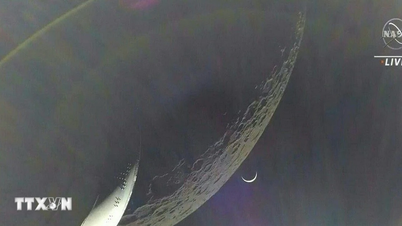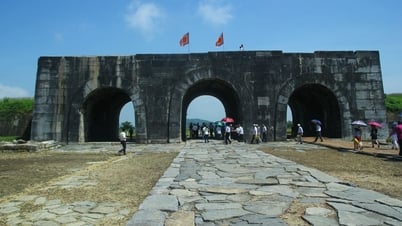The ground vibrates, the signal is transmitted immediately.
Talking about how to record an earthquake, Dr. Nguyen Xuan Anh, Director of the Earthquake Information and Tsunami Warning Center (Institute of Earth Sciences, Vietnam Academy of Science and Technology) said that when there is an unusual vibration in the ground, it will generate seismic waves that propagate underground. Vietnam's monitoring stations stretching from north to south will record this vibration and transmit data via the internet to the Earthquake Information and Tsunami Warning Center.
Here, on the monitoring screen of the officer on duty, the signal wave will suddenly change, turning red. The officer on duty will download this wave segment, conduct a very quick analysis within about 5 minutes to have specific information about the earthquake such as date, time, location, magnitude and risk level.
This information is immediately transferred to the Center's leadership and then the earthquake bulletin will be broadcast in the following order: An earthquake with a magnitude of 3.5 or higher will be first reported to the national agencies with the function of transmitting information and responding the fastest; the remaining earthquakes will be announced immediately on the Center's website.
For earthquakes occurring abroad, the recording is also done similarly. Dr. Nguyen Xuan Anh said: Earthquake data is not only recorded in Vietnam but also recorded regionally and internationally. Many people wonder how long does the Earthquake Information and Tsunami Warning Center have to wait to have information to process and notify when an earthquake occurs in another country?
"In principle, when an earthquake occurs, seismic waves will be generated and these waves will propagate underground. Our monitoring equipment will record them as soon as they reach the station. Recording an earthquake depends on the vibration of the earthquake, so large earthquakes can be recorded from very far away," said Dr. Anh.
Currently, the country has 40 national earthquake monitoring stations operating stably and continuously. The distance between the stations ranges from 200-300km, capable of measuring earthquakes with a magnitude of 3.5 or higher.
When at least 8 Vietnamese monitoring stations record, the system will automatically process the information and provide the earthquake magnitude for quick warning. The processing staff will then assess the earthquake magnitude more accurately.
"For example, the recent Myanmar earthquake's magnitude was initially reported as 7.3, and after correction, it was 7.6. For earthquakes of smaller magnitude, with fewer than 8 recording stations, specialized staff will use specialized software to analyze and provide specific information about an earthquake," Dr. Anh informed.
Earthquake monitoring stations are usually placed on bedrock to ensure high accuracy when recording vibrations. Bedrock is a solid layer of rock deep below the ground, less affected by human impacts such as vehicles or construction activities. Thanks to that, the station receives a “clean” seismic signal, reflecting the true nature of the earthquake. If the station is placed on soft ground, the data may be distorted due to the phenomenon of wave amplification or distortion.
At the Earthquake and Tsunami Warning Center, which is considered the “brain” for receiving and processing seismic information, the staff here hardly know the concept of day or night. They are on duty continuously, straining themselves in each shift, because after an unusual underground vibration, all analysis must be completed within a mere 5 minutes.
Since 2007, the Center has promptly issued notifications for nearly 1,700 earthquakes with magnitudes ranging from 2.5 to 7.6 that have affected Vietnam. In particular, many small earthquakes have been analyzed to serve the research and assessment of earthquake activity in key areas such as hydroelectric dams, construction works and high-risk areas.
The collected seismic data is of great value in studying the structure of the Earth's crust, assessing the level of ground vibration, monitoring the safety of hydroelectric dams and contributing to the design of civil works with the ability to resist earthquakes.
Tsunami warning just minutes after earthquake
In addition to the earthquake monitoring station system, the Center also manages a network of sea level monitoring stations for tsunami warning. When an offshore earthquake of magnitude 6.5 or higher occurs and has the potential to generate a tsunami, the Center's staff will analyze data from the sea level monitoring stations to determine whether or not there is a tsunami.
If there is no unusual change in sea level, it can be confirmed that the earthquake only caused shaking and did not cause a tsunami. However, if there is a sudden change in sea level, it could be a sign that a tsunami is forming, and the Center will issue a warning.
The first bulletin will confirm that the earthquake has the potential to generate a tsunami, then, based on subsequent sea level updates, the Center will issue additional information to determine whether an actual tsunami has occurred.
According to the Center's staff, Vietnam has developed a number of hypothetical tsunami warning scenarios. For example, the Manila subduction zone in the Philippines is an area where there is a possibility of a maximum earthquake of magnitude 9.0. With this magnitude, a tsunami could directly affect the central coastal region.
Simulation scenarios show that if a huge earthquake occurs in this area, the Da Nang area could be affected by a tsunami over 10m high. The time it takes for the tsunami to travel from the Manila area to the Da Nang coast is about 2 hours.
In that case, after about 3-5 minutes from the earthquake, the Center will record the initial signal and proceed to process and issue an early warning about a tsunami according to the established procedure.
Source: https://nhandan.vn/viet-nam-phat-hien-dong-dat-tu-xa-nhu-the-nao-post868531.html


![[Photo] Panorama of the parade celebrating the 50th anniversary of the Liberation of the South and National Reunification](https://vphoto.vietnam.vn/thumb/1200x675/vietnam/resource/IMAGE/2025/4/30/affbd72e439d4362962babbf222ffb8b)



![[Photo] Mass parade to celebrate 50 years of national reunification](https://vphoto.vietnam.vn/thumb/1200x675/vietnam/resource/IMAGE/2025/4/30/825e459ee2f54d85b3a134cdcda46e0d)











![[Photo] Celebrating the 70th Anniversary of Nhan Dan Newspaper Printing House](https://vphoto.vietnam.vn/thumb/402x226/vietnam/resource/IMAGE/2025/4/15/a7a2e257814e4ce3b6281bd5ad2996b8)









































































Comment (0)